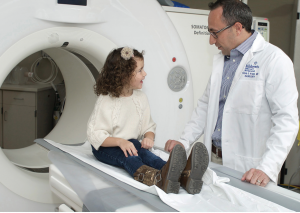
You may notice that we no longer shield patients’ reproductive organs during imaging exams, including Radiography, CT, and Fluoroscopy.
Based on over 70 years of research, medical experts now know that the best way to keep patients safe during imaging exams is to not use shields. This is true at any age, including those who plan to have children in the future. At Children’s Nebraska, we understand that some may view this as different from historical practices in the past, but we want to assure you that patient safety is always
at the forefront of all of our procedures. The following information talks about why we have made this change.
Background
In the 1950s, medical experts had considerably less knowledge about how x-ray radiation used in medical imaging affected our bodies.
One concern was that the radiation might damage cells that could be passed along to future generations. Because of this concern, lead shields were often placed over patients’ reproductive organs during medical imaging exams.
We now know that the best way to safely image you or your child is by forgoing the use of shields.
The amount of radiation used in medical imaging has decreased by over 95% since the 1950s. Better technology means that today’s medical imaging equipment can make high-quality images using minimal amounts of radiation.
Scientists have found that the gonads are much less sensitive to radiation than previously thought. This is true for everyone, including children and adults who plan to have children in the future.
Shields can cover parts of the body that your doctor needs to see. In this example, the exam may need to be repeated.
Shields can also interfere with other dose-saving features. X-ray equipment includes technology that ensures just the right amount of radiation is used for the exam. Sometimes a shield can interfere with this technology, which can increase the amount of radiation from the exam.
Supported By
- American Association of Physicists in Medicine (AAPM)
- American Board of Radiology
- American College of Radiology (ACR)
- American Society of Radiologic Technologists
- Image Gently
- Society for Pediatric Radiology (SPR)
Additional Resources
- The American Association of Physicists in Medicine: Communicating Advances in Radiation Education for Shielding (CARES)
- British Institute of Radiology
Do you have more questions related to shields during imaging exams? Contact the Radiology Child Life Specialist at 402-955-4042 or the Radiology Department at 402-955-5602.
What To Do Next
For Patients
Your child will need an order from a provider to schedule a radiology procedure. Once the order is placed, call 402-955-6799 to schedule the procedure.
For Referring Providers
The Physicians’ Priority Line is your 24-hour link to pediatric specialists at Children’s for referrals, emergency and urgent consults, physician-to-physician consults, admissions, and transport services. Call 855-850-KIDS (5437).
Learn more about referring patients.